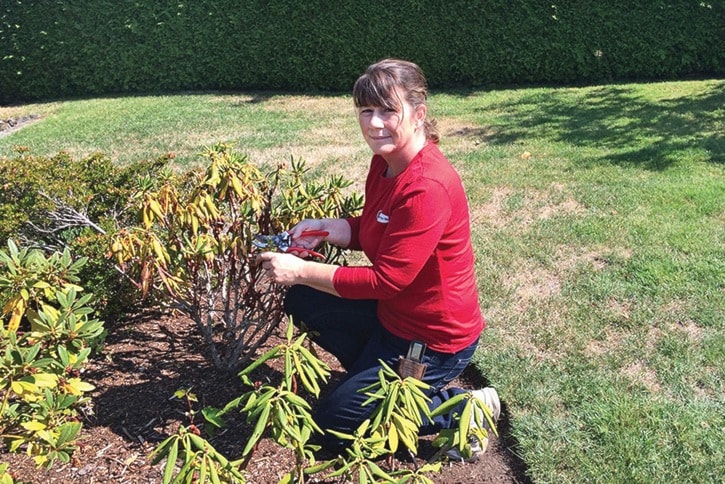This long, hot summer has seen some sizzling market moves, but has been a tough one for local landscaping companies.
Niki Ottosen, owner of Gardener for Hire, a Colwood-based property maintenance company, said businesses like hers are taking a hit, and not just from the weather. She said misconceptions about watering restrictions and increased pressure from big corporations muscling their way onto the Island have forced her to trim employees.
“We’re just not getting as many calls,” she said, adding the biggest hit to their business has been from residential customers. “Billable hours have definitely gone down.”
She anticipated some drop in residential calls when the season started with a heat wave. As such, she took some precautions. “We’ve had to spend more money on advertising and less money on employees.” She cut her staff from four to three to keep them all busy with full-time hours. “We’ll definitely have to make some changes if this is going to be the trend.”
Ottosen said August is usually a slow month, but with the growing season about three weeks ahead, that slow period started in mid-July and is expected to last until at least mid September, twice as long as usual.
She noted it’s a healthy balance between commercial and residential contracts that keep a business going. In her case, combined with residential calls dropping off, commercial clients have been more demanding due to the heat, she said. Her company is responsible for watering as well as maintenance on commercial contracts, which include strata developments, where her residential clients are responsible for their own watering schedule.
“Homeowners are giving up on their lawns and their gardens.” Evidence of this was pretty clear, she said, after a drive around the area revealed a considerable number of dead mature trees and shrubs. She fears a number of homeowners will not be able to afford to replace them in the current economy. “Most homeowners can only afford maintenance.”
She attributed some of the drought damage to the misconception that the West Shore was under extreme watering restrictions, after news of the Cowichan Valley’s stage 3 restriction spread, and because this summer has been one of the driest on record. As a result, a number of residents she has spoken to stopped watering earlier than usual.
Even with an increased demand earlier in the year and limited rainfall, the West Shore has remained under the typical stage 1 water conservation restrictions Those are in effect every year between May 1 and Sept. 30 and allow for lawns to be watered twice a week between 4 to 10 a.m. and 7 to 10 p.m. on days designated by address. Houses with even addresses may water on Wednesdays and Saturdays, odd addresses on Thursdays and Sundays. Although, the CRD has urged residents to reduce their outdoor water use to maximize reserves.
Ottosen noted that residents can hand water whenever they need and she suggests this for any young plants that have been in the ground less than a year, or any established plants starting to show drought damage.
Besides the changing weather patterns, Ottosen said an industry change has put pressure on local companies. Larger property maintenance companies with head offices in Vancouver or Toronto have set up shop on the Island because of its mild climate, she said. She once believed there was enough work to go around, but now she’s not so sure.
“We’ve lost a few major contracts.”
She said a number of these companies only operate for certain seasons, and she’s seen work such as lawn aerating done well before the proper season, to beat local competitors, and then they’re gone.
“Local businesses will be more inclined to help you through the seasons. We’ll be there to help you through the drought and after it,” she said.
katie@goldstreamgazette.com
Q: WHAT’S THE BEST TIME TO REPLACE DEAD PLANTS AROUND MY HOME?
Fall is the best time to replace plants that have died in the summer, says Niki Ottosen, owner of Gardener for Hire.
If a mature plant or shrub looks like it has died, she counsels to not give up hope. Continue to hand-water the plant, hosing down the base long enough to penetrate three to four inches to ensure the root system is getting water. She notes this is important to do for any established trees or shrubs that are showing signs or wilting.
Mature plants are often resilient and will come back the next year if you continue to water them once they have gone into survival mode. This can often make it look like the plant has died, but Ottosen said that isn’t usually the case with conifers like fire, spruce and cedar trees.
A scratch test will determine if a plant has died or gone dormant. Do this by gently scratching a small piece of a branch with your finger nail. If it’s green underneath the plant is still alive and you should continue watering it. If it’s brown, test the plant further down the base to find out how far the die back has occurred.
GREATER VICTORIA MARKET UPDATE » MONTH TO DATE AUG. 10/15 COURTESY VICTORIA REAL ESTATE BOARD
» 170 / 609 -- NET UNCONDITIONAL SALES / TOTAL, AUGUST 2014
» 267 / 904 --NEW LISTINGS / TOTAL, AUGUST 2014
» 3,852 / 4,316 -- ACTIVE RESIDENTIAL LISTINGS / TOTAL, AUGUST 2014
